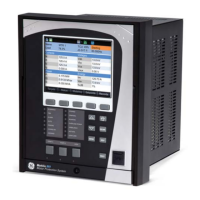1–16 869 MOTOR PROTECTION SYSTEM – INSTRUCTION MANUAL
SPECIFICATIONS CHAPTER 1: INTRODUCTION
OVERFREQUENCY (81O)
Pickup Level: .........................................................20.00 to 65.00 Hz in steps of 0.01
Dropout Level:......................................................Pickup - 0.03 Hz
Pickup Time Delay:.............................................0.000 to 6000.000 s in steps of 0.001 s
Dropout Time Delay: .........................................0.000 to 6000.000 s in steps of 0.001 s
Minimum Operating Voltage:........................ 0.000 to 1.250 x VT in steps of 0.001 x VT
Level Accuracy:.................................................... ± 0.001 Hz
Timer Accuracy: ..................................................± 3% of delay setting or ± ¼ cycle (whichever is greater) from
pickup to operate
Operate Time: ......................................................typically 7.5 cycles at 0.1 Hz/s change
typically 7 cycles at 0.3 Hz/s change
typically 6.5 cycles at 0.5 Hz/s change
FAST PATH:
Typical times are average Operate Times including variables such as frequency change
instance, test method, etc., and may vary by ± 0.5 cycles.
FREQUENCY RATE OF CHANGE (81R)
df/dt Trend:............................................................Increasing, Decreasing, Bi-directional
df/dt Pickup Level:.............................................. 0.10 to 15.00 Hz/s in steps of 0.01 Hz/s
df/dt Dropout Level: ..........................................96% of Pickup Level
df/dt Level Accuracy:........................................ 80 mHz/s or 3.5%, whichever is greater
Minimum Frequency:........................................ 20.00 to 80.00 Hz in steps of 0.01 Hz
Maximum Frequency:.......................................20.00 to 80.00 Hz in steps of 0.01 Hz
Minimum Voltage Threshold: ........................0.000 to 1.250 x VT in steps of 0.001 x VT
Minimum Current Threshold: ........................0.000 to 30.000 x CT in steps of 0.001 x CT
Pickup Time Delay:.............................................0.000 to 6000.000 s in steps of 0.001 s
Timer Accuracy: ..................................................± 3% of delay setting or ± ¼ cycle (whichever is greater) from
pickup to operate
95% Settling Time for df/dt: .......................... < 24 cycles
Operate Time: ......................................................typically 10 cycles at 2 × Pickup
RTD PROTECTION
Pickup:......................................................................1°C to 250°C in steps of 1°C
Hysteresis:.............................................................. 2°C
Timer Accuracy: .................................................. <2 s
Elements:................................................................Trip and Alarm
FLEXELEMENTS
Number of elements:........................................8
Operating signal: ................................................Any analog actual value, or two values in a differential mode
Operating signal mode:...................................Signed, or Absolute value
Operating mode:.................................................Level, Delta
Comparison direction:......................................Over, Under
Pickup Level: .........................................................-30.000 to 30.000 pu in steps of 0.001 pu
Hysteresis:..............................................................0.1 to 50.0% in steps of 0.1%
Delta dt:...................................................................40 msec to 45 days
Pickup and dropout delays:...........................0.000 to 6000.000 s in steps of 0.001 s
(NOTE 1) When the setpoint “Motor Load Filter Interval” is programmed as non-zero, it
might increase the trip/alarm times by 16.7 ms (or 20 ms at 50 Hz) for each additional cycle
in the filter interval for the following protection elements: Acceleration Time, Current
Unbalance, Mechanical Jam, Overload Alarm, Thermal Model, Undercurent, Power Factor,
and Underpower.

